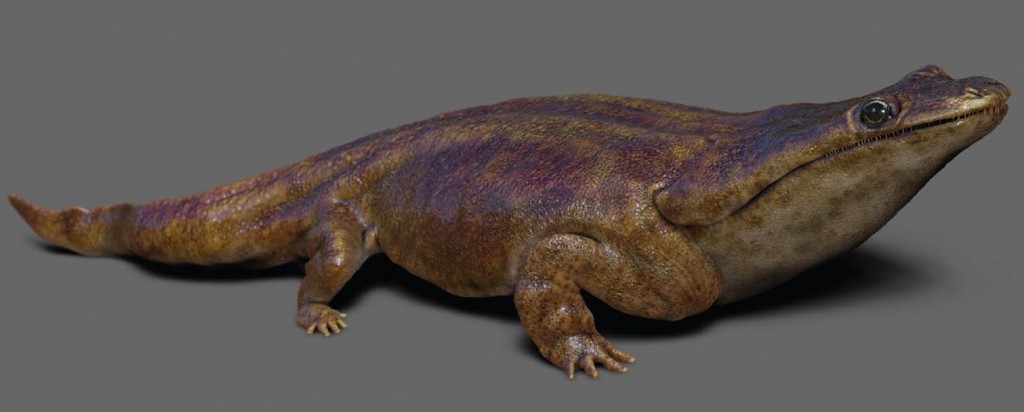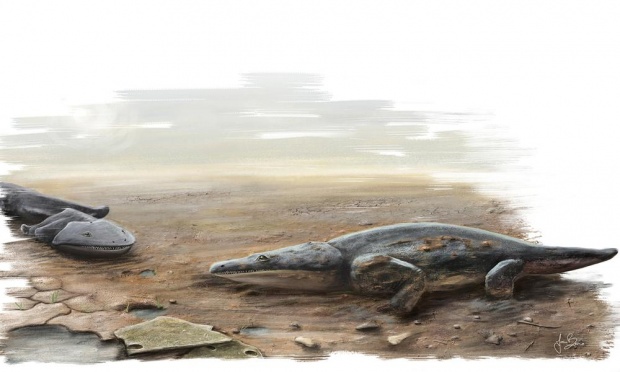Loulé and the neighboring municipality of Silves, which share the same page of geological history, are committed to creating the first Geopark in the entire Algarve. The pretext is the rich paleontological heritage that, in recent years, has been revealed in the sandstone strip and of which the Estrela is Metoposaurus algarvensis, an amphibian that lived in the Penina area, in the interior of the municipality of Loulé, there is nothing more, nothing less than 227 million years ago.
«At this moment, we are aspiring to UNESCO World Geopark», having already been delivered a first dossier with the intention of candidacy. "We now have two years to prepare the formal candidacy dossier," revealed Dália Paulo, director of the Loulé Chamber, in an interview with Sul Informação.
When formalized, the Loulé/Silves Geopark will start from the Penina geosite, one of the «worldwide reference geosites», as the fossil of the huge amphibian was found there, which is a new species to science and, therefore, reflects on the its name its algarvian origin, Metoposaurus algarvensis.
But, underlined Dália Paulo, "it will still allow working the interior from an economic point of view, based on this geological and paleontological wealth, but also on its natural, landscape and even ethnographic wealth". It is that, he stressed, "without people, there is no geopark".
In order to give substance to this Geopark project, the Câmara de Loulé recently hired a young paleontologist, Hugo Campos, 27 years old, who recently finished his master's degree at the Faculty of Science and Technology of the Universidade Nova de Lisboa. Hugo Campos received a scholarship from the António Aleixo Foundation, which allowed him to specialize in his chosen field.
The future Geopark will have as technical director Cristina Veiga-Pires, a professor at the University of Algarve, an entity that is also linked to the candidacy led by the Câmara de Loulé.
While the Geopark is not created, the public can already see up close, at the Municipal Museum of Loulé, the fossil of this huge animal, which lived in a lake area that existed more than 220 million years ago, in the territory that today is the interior of the county.
In terms of appearance, the Metoposaurus it looks like a giant salamander, but in fact, as the row of sharp teeth indicates, it was a carnivorous predator.
The flat skull of a young specimen and part of an adult one, as well as a jaw of that prehistoric Triassic amphibian, can now, since the end of July, be seen in a room at the Museum of Loulé, side by side with another animal that lived in the Penina area, a Phytosaurus, a reptile with a body similar to a crocodile, but with the nostril close to the eyes, which allowed them to breathe with almost the entire body submerged.
Phytosaurs became extinct 200 million years ago and the jaw and teeth displayed in the Museu de Loulé are the only known remains in the entire Iberian Peninsula.
The fossils of these animals are now on display, each one in its window, side by side, in the Loulé museum, arousing the curiosity of many visitors, especially children. "The fossils have only been here for a little over a month, before they were in Lisbon, at the National Archeology Museum, but now, with the beginning of classes, we should start receiving visits from schools just to see them", said Ana Rosa Sousa, technical director of the museum structure.

But the paleontological richness is such that in the Penina and other deposits there is still a lot to investigate, since excavations were only carried out in a very small part of the Triassic rocks. "This year there won't be any excavation campaign on the ground, but next year we're already planning it," revealed Dália Paulo.
These fieldworks are led by Professor Octávio Mateus, with the participation of teams of volunteers from the Lourinhã Museum and other researchers and students. The young paleontologist from the Division of Museums and Heritage of the City of Loulé will also join the team. As a matter of fact, explained Dália Paulo, the future creation of the Geopark implies “constituting a mini team” that will permanently deal with this work and everything that has to do with paleontology.
To accommodate this completely new area of museology in the Algarve – in Portugal, there is only parallel in the Lourinhã Museum – the Loulé Museum will soon have an entire room dedicated to paleontology, with its Metoposaurus algarvensis as a central figure
And it will also have a paleontology laboratory, which will avoid having to resort to the Lourinhã Museum or the Universidade Nova de Lisboa.
The new room and the future laboratory will be created by the major restructuring of the museum that is being programmed by the City of Loulé and which will involve a total investment of 5 million euros, as well as the creation of a true "cultural quarter" in the city, enlarging the museological structure, from its current location, in the former mayor of the castle, to the neighbors Convento do Espírito Santo, ruins of the Islamic Baths and adjoining buildings.
"There is no other museum in the Algarve that tells the history of the Algarve in terms of paleontology," explained Dália Paulo to Sul Informação. "It will be a way of complementing the history that is told in the Algarve's museums," he added. And to go back to this story that is told in at least 227 million years.

And what is this story, which has already started to be told at the Museu de Loulé? It tells the story of those ancient times when the continents were still all united in Pangea, surrounded by the great ocean Pantalassa. In the interior of what is now the municipality of Loulé and neighboring Silves, there was a system of large lakes and rivers, where animals such as the Metoposaurus algarvensis, the Phytosaurus or Placodon, «a small aquatic reptile», whose fossil was discovered in the same sandstone formation, but in the area of São Bartolomeu de Messines.
“Usually, these Placodons feed on molluscs with shells, which they crushed with their strong jaws, but ours could be different, perhaps it was herbivore”, explained Hugo Campos.
The paleontologist is excited about the work ahead. With new campaigns of excavations in the field, he admits that "more species could appear". «We have already found traces of Placodonte, such as the one discovered in the municipality of Silves, but close to Rocha da Pena, in Loulé. In Spain, associated with Placodon, there are other animals. Who knows what can be discovered here?».
As for the fossil that is the Estrela, the one of Metoposaurus algarvensis, Hugo Campos highlights the fact that it is an «animal that is only found in the Algarve, in one of the richest fossil sites in the country. Due to the size of this Penina deposit, we estimate that there are dozens of individuals there. 227 million years ago, there was a catastrophic episode whose origin is not established, but which led to the lake's disappearance, very quickly, and a mass death of these animals. You Metoposaurus they were concentrating on the last remnants of water and ended up dying».
"The gender Metoposaurus it is found in Germany, France, Poland, Morocco, here in Portugal, namely in the Algarve, with this species. This shows the world these animals lived in», when there was only one supercontinent, Pangea.
In Rocha da Pena, «above these, there are limestone levels, of marine environments, when the separation of the continents began and the oceans appeared», adds the paleontologist.
In other words, the geological history of the interior of the municipalities of Loulé and Silves, especially the Penina geosite, allows us to explain what life was like in the primordial times of Pangeia, but also in what followed, the separation of continents and the creation of several oceans. And working on this very long diachrony of the territory is one of the great objectives of the Loulé Museum and of the municipality itself, now so committed to the issue of climate change as well.
While the Geopark projects and the deep restructuring of the Museum are not completed, for now there is a new attraction to visit Loulé and its still small museum: «see the fossils of these animals with more than 220 million years, which no one can see in nowhere else!», concludes Hugo Campos.





















Comments